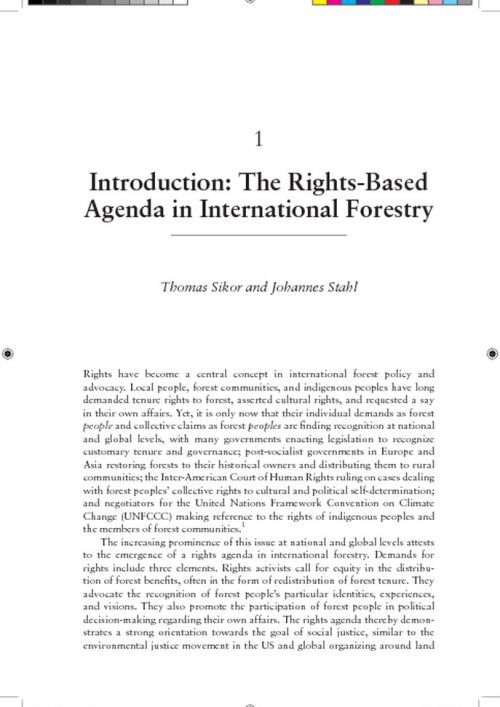APA 6th ed. Introduction: The Rights-Based Agenda in International Forestry. (2011, July 1). Retrieved from https://voices4mekongforests.org/publications/0000116
MLA 8th ed. Introduction: The Rights-Based Agenda in International Forestry. RECOFTC, 1 July 2011, https://voices4mekongforests.org/publications/0000116.
Chicago 17th ed. RECOFTC. 2011. "Introduction: The Rights-Based Agenda in International Forestry." Published July 1, 2011. https://voices4mekongforests.org/publications/0000116.
Introduction: The Rights-Based Agenda in International Forestry

This is a review of a new book edited by Thomas Sikor and Johannes Stahl, Forests and People: Property, Governance, and Human Rights on the rights-based approach in forestry.
Available from: Earthscan, London and New York. Download the Introduction at left.
Rights-based approaches have become an important aspect of the general development debate during the past decade and are increasingly emphasized at international and national conferences and workshops. Rights are frequently cited as a rationale for demanding action to change national regulatory frameworks as well as for more fundamental societal changes. This book, edited by Thomas Sikor and Johannes Stahl, aims at advancing the rights agenda as it applies to forests, with an underlying premise that such scholarship is critical to the pursuit of socially just forestry. The book consists of a series of chapters written by participants at a workshop on forest rights held at the University of California, Berkeley, in 2009.
The editors also author the Introduction and the Epilogue, both of which are worth reading in their own right. The Introduction serves as a useful primer for those coming to the subject for the first time, as it unpacks the notion of rights and provides useful insights. The position is argued that forest rights differ from more widely applied rights-based approaches in international development, with three important differences:
“First, redistribution is a central demand of activists in forestry, but not in the other fields. Many forest rights activists are calling for not only the redirection of benefit streams to forest people, but also the redistribution of forest tenure to them upon the background of entrenched historical inequalities. Second, the rights agenda in forestry emerges from longstanding demands expressed by forest people in numerous grassroots initiatives. These grassroots foundations set it apart from rights-based approaches in development and conservation, which typically derive their legitimacy from transnational human rights norms and are largely driven by international and national organizations. Third, forest rights activists attend to people’s individual rights as well as peoples’ collective rights. In contrast, rights-based approaches in the other fields tend to emphasize individual rights.” (Chapter 1, p. 2)
The point is made that the contemporary forest rights agenda brings together three distinct threads:
- calls for redistribution of forest tenure,
- indigenous peoples’ rights of self-determination, and
- basic human rights.
It is also noted that the emphasis given by different activists tends to reflect their origins in terms of these three threads. The authors of Chapter 1 argue that forest rights activists do share a common agenda, although in other parts of the book it is stated that the forest rights agenda remains highly diverse, as activists operationalize their shared commitment to social justice in different ways.
The chapters in the book are grouped into five blocks: I Global perspectives; II What claims find support? III Whose claims are considered to constitute rights? IV What authorities recognize forest people’s rights? V What political strategies serve rights recognition by the state?
In spite of differences in emphasis, a common thread throughout the book is in seeking strategies to overcome the entrenched economic, political, and cultural inequalities that characterize forested areas in many parts of the world. It is noted that this emphasis on social justice can put activists at odds with others, as they find themselves confronted with efforts to appropriate their agenda by actors who do not share their goal of redistribution, as has occurred in community-based natural resource management.
Perhaps one of the most important conclusions that can be drawn from the book is that forest rights cannot be realized through minor changes in existing regulatory regimes. Real and lasting change can only come about through broader political reforms that enable marginalized people to mobilize their legal forest rights.
ISBN: 978-1-84971-280-4

